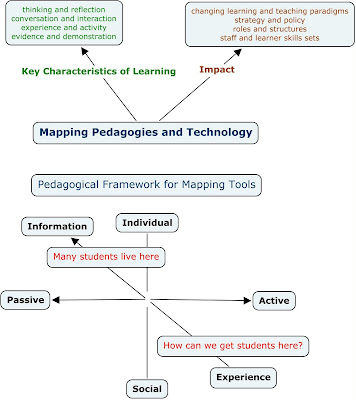
In New Schemas for Mapping Pedagogies and Technologies, Grainne Conole "reflects on the implications of Web 2.0 for education and offers two new schemas for thinking about harnessing the potential of technologies", focusing specifically on Web 2.0 technologies. The portion of the article that resonated most with me is the pedagogical framework for mapping tools (see concept map above). Conole identifies 3 dimensions that span from information to experience, passive to active learning, and individual to social learning. I immediately recognize that most classroom learning takes place in the upper left corner of the framework. Most of our students individually learn knowledge-level information in a passive manner. ESSENTIAL QUESTION: How do we move our students toward the lower right corner where they can actively experience learning with others?
Conole offers a matrix of principles against the learning characteristics they promote. For example, frequent interactive exercises and feedback promote thinking and reflection, conversation and interaction, as well as evidence and demonstration. Allowing users to build a reputation in the system promotes experience and activity. Conole further identifies personal learning networks as a means for creating a custom learning experiences.
I see personal learning environments as the key to a connectivist approach. Learner freedom to choose connections and navigate the network is crucial. It's what separates a group from a network, structured closed learning environments from open, distributive from distributed. If we put structure around this PLE, it no longer maintains all of the characteristics of an open network. Perhaps we should...
- focus our teaching time on effective methods for building a personal learning environment
- provide guidance and feedback as our students create this environment
- offer support and challenge students to push themselves further, especially when they fail to take ownership of the learning process
- share in their successes and provide additional avenues for sharing with others
- Clearly define the social object your service is built around
- Define the verbs that users perform on the objects so that it is clear what the site is for (how many Web 2.0 tools have you visited with absolutely no clue as to what they do?)
- Make the objects sharable
- Turn invitations into gifts (provide motivation for others to participate)
- Charge publishers, not spectators
- Enabling practice
- Mimicking reality
- Building identify
- Actualizing self
I'm not sure I have all the components necessary to design an effective social networked learning experience, but I do feel that we're getting closer. I think that the lessons of this week provide some building blocks that will continue to surface as we progress through the course.
References
CloudWorks. (n.d.). Retrieved Oct. 18, 2008, from http://cloudworks.open.ac.uk/.
Conole, G. (n.d.). New Schemas for Mapping Pedagogies and Technologies. Retrieved Oct. 19, 2008, from http://www.ariadne.ac.uk/issue56/conole/.





3 comments:
Terrific post, Wendy. I read your ideas with relish. I too was most intrigued by Grainne Conole's model (robinheyden.wordpress.com) and agree that our students today are spending most of their time in the upper left quadrant. In addition to your question, "how do we move our students to the lower right corner?", I pose the question, shouldn't we discover an optimal coordinate spot on the frameowrk for each desired learning outcome and design the learning experience accordingly? Adn I love your phrase, "to turn invitations into gifts"....to encourage participation. Very, very nice.
Wendy
I think this is an important week too. The readings are a great stimulus to consider facilitating learning. Gráinne’s papers give some very tangible approaches to learning contexts. Your graphic prompted me to think about PLEs and their used in mixed ability teaching. I am fascinated now by how social objects can be the catalyst for individualised learning and guided discovery.
Thanks for posting your thoughts.
Keith
Wendy, enjoyed your post - found it through Google when looking up CloudWorks. I agree with Robin that Gráinne’s papers are well written and worth coming back to.
One point that I'm not sure about with your questions related to the desire to move our students from one quadrant to another. Does this assume learning most effectively takes place in the bottom right hand corner?
George, in his presentation this week, talks about the importance of context for the design process. The ecology needed for a fireman is different for the poet. So perhaps our learning design needs to vary according to the context.
I enjoyed your post it is helping me to get my thoughts together for my own blog - sometimes the connections happen more slowly.
Post a Comment